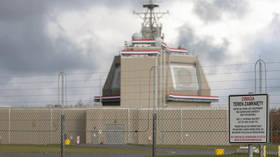Apocalyptic 100ft ‘firenado’ sprouts from Idaho wildfire (VIDEO)

A giant “firenado” – a twister of smoke, fire and burning debris – was filmed shooting into the air above Idaho’s Soda Fire late last week, and the footage of apocalyptic tornado is now spreading across the Internet with a slightly less deadly force.
“This sucker was shooting flames 100ft (30m) in the air before it passed right in front of the line,” Idaho firefighter Craig Fluer wrote on Instagram, “all while dropping hot dirt and ash on our helmets.”
A truly unique phenomenon, the fire twister formed due to intense rising heat under strong wind conditions, sucking in burning debris and combustible gases. A twister consists of a fire core in addition to an invisible rotating pocket of air. At its peak “firenado" can reach up to 2,000 degrees Fahrenheit (1,090 degrees Celsius).
Fluer filmed the Idaho fire tornado last week during the ongoing wildfire in Idaho. The natural disaster has now consumed over 285,000 acres in southwestern Idaho and southeastern Oregon, prompted by high temperatures and low moisture.
Idaho 'fire tornado' shoots flames hundreds of feet into the air http://t.co/uUoBMr33U2pic.twitter.com/9nTOQPzDgi
— Telegraph News (@TelegraphNews) August 20, 2015“It was driven by extreme weather that we haven't seen in this part of the country in almost 90 years,” said Tim Murphy, the state director of the Idaho Bureau of Land Management.
Now, just over a week since the fire first ignited, it has been listed as 95 percent contained. No injuries have been reported, but as the flame spread it managed to kill scores of farm animals and wildlife.
Firefighter captures incredible footage of “firenado” http://t.co/loMdJf8ES9pic.twitter.com/nYHoF2GBCx
— WPXI (@WPXI) August 19, 2015Idaho Cattle Association has blamed the extent of the wildfire on the lack of grazing across the rangeland due to state complications in obtaining grazing permits, claiming that if cattle could graze more land, there would be less fuel for fires.
“Graze it, don't blaze it,” Wyatt Prescott, executive vice president told KTVB local news.
“Grazing by livestock, wild horses, elk in higher country, certainly can have an effect on fueling,” Murphy agreed.












